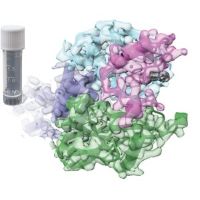Specification
| Organism | Homo sapiens (Human) |
| Expression Host | E.Coli |
| Tag Info | N-terminal 6xHis-tagged |
| Purity | >97% as determined by SDS-PAGE and HPLC. |
| Uniprot ID | P01375 |
| Uniprot Entry Name | TNFA_HUMAN |
| Gene Names | TNF,TNFA,TNFSF2 |
| Alternative Names | Cachectin, Tumor necrosis factor ligand superfamily member 2, TNF-a, , NTF |
| Expression Region | Partial (77-233aa) |
| Molecular Weight | 18.3 kDa |
| Endotoxin | Less than 1.0 EU/µg as determined by LAL method. |
| Sequence | MHHHHHH+VRS SSRTPSDKPV AHVVANPQAE GQLQWLNRRA NALLANGVEL RDNQLVVPSE GLYLIYSQVL FKGQGCPSTH VLLTHTISRI AVSYQTKVNL LSAIKSPCQR ETPEGAEAKP WYEPIYLGGV FQLEKGDRLS AEINRPDYLD FAESGQVYFG IIAL |
| Product Form | Lyophilized powder (Lyophilized from a 0.2 m filtered PBS, pH 7.0) |
| Reconstitution | Please reconstitute protein in deionized sterile water and we recommend that briefly centrifuge thevial prior to opening the vial .We recommend aliquot for long-term storage at -20℃/-80℃. |
Background
| Relevance | Cytokine that binds to TNFRSF1A/TNFR1 and TNFRSF1B/TNFBR. It is mainly secreted by macrophages and can induce cell death of certain tumor cell lines. It is potent pyrogen causing fever by direct action or by stimulation of interleukin-1 secretion and is implicated in the induction of cachexia, Under certain conditions it can stimulate cell proliferation and induce cell differentiation. Impairs regulatory T-cells (Treg) function in individuals with rheumatoid arthritis via FOXP3 dephosphorylation. Upregulates the expression of protein phosphatase 1 (PP1), which dephosphorylates the key 'Ser-418' residue of FOXP3, thereby inactivating FOXP3 and rendering Treg cells functionally defective (PubMed:23396208). Key mediator of cell death in the anticancer action of BCG-stimulated neutrophils in combination with DIABLO/SMAC mimetic in the RT4v6 bladder cancer cell line (PubMed:22517918). {ECO:0000269|PubMed:16829952, ECO:0000269|PubMed:22517918, ECO:0000269|PubMed:23396208}.; The TNF intracellular domain (ICD) form induces IL12 production in dendritic cells. {ECO:0000269|PubMed:16829952}. |
| Function | Cytokine that binds to TNFRSF1A/TNFR1 and TNFRSF1B/TNFBR. It is mainly secreted by macrophages and can induce cell death of certain tumor cell lines. It is potent pyrogen causing fever by direct action or by stimulation of interleukin-1 secretion and is implicated in the induction of cachexia, Under certain conditions it can stimulate cell proliferation and induce cell differentiation. Impairs regulatory T-cells (Treg) function in individuals with rheumatoid arthritis via FOXP3 dephosphorylation. Upregulates the expression of protein phosphatase 1 (PP1), which dephosphorylates the key 'Ser-418' residue of FOXP3, thereby inactivating FOXP3 and rendering Treg cells functionally defective |
| Involvement in disease | Psoriatic arthritis (PSORAS) |
| Subcellular Location | Cell membrane, Single-pass type II membrane protein, SUBCELLULAR LOCATION: Tumor necrosis factor, membrane form: Membrane, Single-pass type II membrane protein, SUBCELLULAR LOCATION: Tumor necrosis factor, soluble form: Secreted, SUBCELLULAR LOCATION: C-domain 1: Secreted, SUBCELLULAR LOCATION: C-domain 2: Secreted |
| Protein Families | Tumor necrosis factor family |
| Tissue Specificity | |
| Pathway | MAPKsignalingpathway |
QC Data
| Note | Please contact us for QC Data |
| Product Image (Reference Only) |  |

